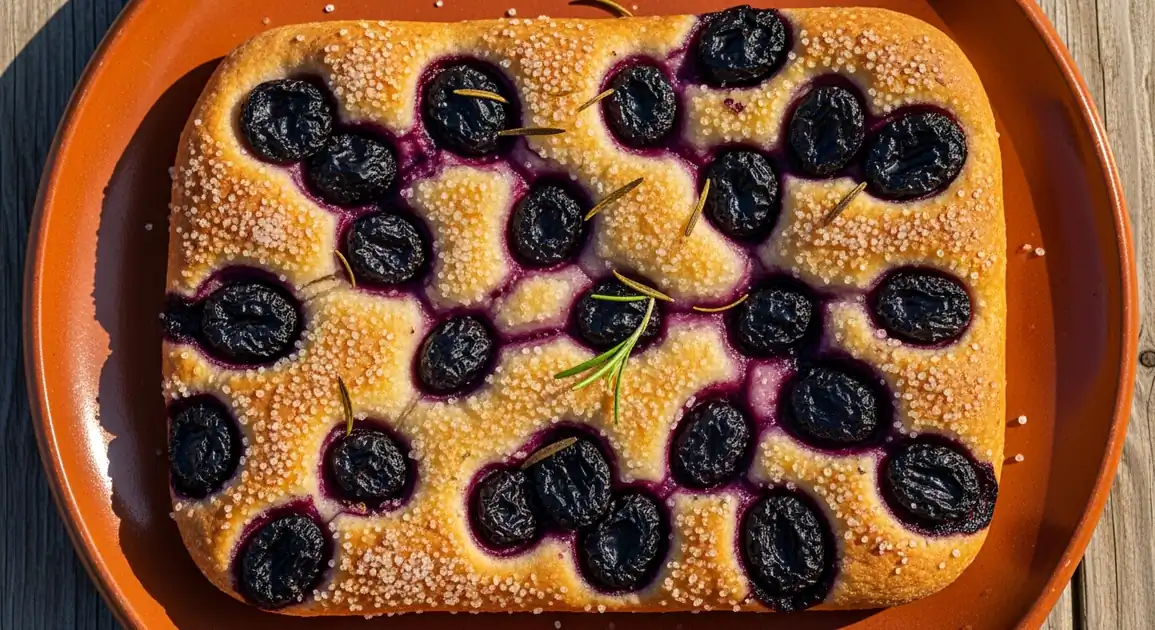Schiacciata con l'uva (Grape Flatbread)
Schiacciata con l'uva

Description
Florence (Firenze) is the spiritual home of Schiacciata con l'uva, where this seasonal specialty appears in virtually every neighborhood bakery during the autumn grape harvest. Florentine versions are characterized by their perfect balance of sweetness and wine-grape tartness, with a reverence for traditional preparation methods passed down through generations.
Dietary Information
Serving information
Serving style
In Florence, traditionally cut into rectangular pieces and served simply on bakery paper. No garnishes or accompaniments are needed, though some Florentines pair it with a small glass of Vin Santo.
Quick facts
Most Florentine bakeries open 7 AM - 1 PM, then 4 PM - 7 PM. Some tourist-area bakeries maintain continuous hours.
Safety Tips
What to Look For
-
Made with wine grapes, not table grapes
Authentic schiacciata con l'uva uses wine grapes (smaller, with seeds) which have the proper flavor profile and juice content. Table grapes create an inferior product.
-
Vibrant grape juice staining throughout the bread
Good schiacciata should show purple-red marbling where grape juice has infused the dough, indicating proper preparation and fresh grapes.
-
Baked same-day
This specialty deteriorates quickly - ask when it was baked ('Quando è stata sfornata?'). Best quality is within hours of baking.
-
Stored at room temperature, not refrigerated
Proper storage maintains texture. Refrigeration harms the consistency of the bread and dulls flavors.
What to avoid
-
Pre-packaged versions with extended shelf life
These contain preservatives and miss the ephemeral quality of fresh-baked schiacciata con l'uva.
-
Overly dry appearance or texture
Indicates the schiacciata is old. The interior should remain somewhat moist from grape juices.
-
Bright purple artificial coloring
Natural grape juice staining has a more muted purple-red hue. Vibrant purple may indicate artificial coloring.
-
No visible grape skins or evidence of real grapes
Authentic versions must contain actual grapes, not just flavoring or jam.
Price information
Price range
Budget tips
- Neighborhood bakeries in residential areas like Sant'Ambrogio or San Frediano offer better value (2.50-4.00 EUR per piece) than tourist-area bakeries.
- Some places sell by weight - ask for a smaller piece ('un pezzo piccolo') if you just want to taste.
- Historic central bakeries charge premium prices (5.00-7.00 EUR) for essentially the same product.
- Visit in the morning when most bakeries offer freshly made batches at regular prices.
Value indicators
- Made with Tuscan wine grapes (ideally Canaiolo).
- Proper thickness - should be about 1.5-2 cm high with good grape distribution.
- Subtle hint of olive oil and possibly rosemary or anise.
- Well-caramelized sugar crust without being burnt.
- Distinctive wine-like fermented aroma.
Where to Find This Dish
Sant'Ambrogio
This authentic neighborhood near the Mercato Sant'Ambrogio has several old-school bakeries known for excellent traditional baked goods.
Mercato Sant'Ambrogio, Via Pietrapiana
Morning, Mid-afternoon
San Lorenzo / Central Market Area
Several historic bakeries around the Mercato Centrale offer traditional versions, though prices can be higher in this tourist area.
Mercato Centrale, Via dell'Ariento
Morning, Midday
Santo Spirito / San Frediano
This Oltrarno area has authentic neighborhood bakeries frequented by locals, often with excellent quality and reasonable prices.
Piazza Santo Spirito, Via di Santo Spirito
Morning, Afternoon
Gavinana / Galluzzo
These residential areas outside the historic center have family-run bakeries with more traditional, less tourist-oriented offerings.
Local piazzas, Neighborhood markets
Morning
Vendor Tips
- Look for bakeries with 'forno artigianale' or 'dal 19XX' signs, indicating traditional methods.
- Ask if they use Canaiolo grapes specifically ('Usate uve Canaiolo?'), considered the most traditional.
- If you see locals queuing, it's usually a good sign of quality and freshness.
- Request a piece from a fresh batch if possible ('È appena sfornata?').
How to Order
Regional Variations
-
Historic Center Style
(Versione del Centro Storico)
Bakeries in Florence's historic center often make slightly sweeter, thinner versions with higher sugar content, catering somewhat to tourist preferences.
-
Countryside Style
(Versione di Campagna)
Bakeries in Florence's outskirts and surrounding areas often create rustic versions with more olive oil, thicker dough, and sometimes the addition of fennel seeds alongside anise.
-
Double Dough Version
(Versione a Doppio Impasto)
Some Florentine bakers create a specific style with a thicker bottom layer and thinner top layer, maximizing the contrast between the crisp top and juice-soaked bottom.
-
Santo Spirito Style
(Versione di Santo Spirito)
Bakeries in this artistic neighborhood sometimes add rosemary and a hint of orange zest, creating a more aromatic version particularly popular with locals.
Cultural context
History
This traditional flatbread dates back to the Etruscan era and is deeply connected to Tuscany's wine culture. Historically prepared during vendemmia (grape harvest) in September-October, it was a practical way to use excess wine grapes while celebrating the harvest season. The name 'schiacciata' (meaning 'squashed' or 'flattened') refers both to the flattened dough and the pressed grapes. While originally a rural specialty, it became a beloved seasonal staple throughout Florence and Tuscany, representing agricultural traditions and seasonal eating patterns.
Local significance
In Florence, schiacciata con l'uva represents not just harvest traditions but the city's proud artisanal baking heritage. It's seen as a strictly seasonal treat that marks autumn's arrival and connects urban dwellers to the surrounding countryside's agricultural rhythms.
Eating customs
- Florentines often enjoy it as a mid-afternoon break, sometimes with a coffee.
- Some pair it with young cheeses like pecorino fresco for a sweet-savory contrast.
- Older Florentines may reminisce about harvest traditions while enjoying this seasonal treat.
- Buying it from your neighborhood baker ('fornaio di fiducia') is part of the tradition.